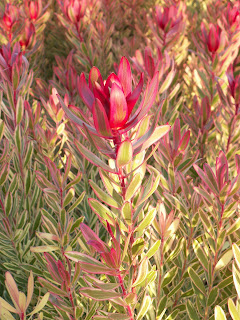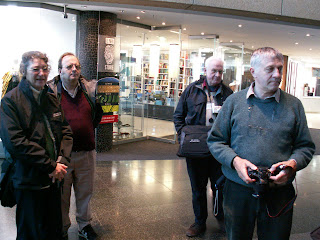

















Tuesday 20 May A Bombay Mix – Growing Spectrum, Bruntwood Nurseries and Hamilton Garden
First visit of the day was to Growing Spectrum ,a nursery of high standards and great aspirations. The nursery produces in the region of 400K trees and shrubs annually for the retail market. Innovation and marketing are two key components of this successful business. The plant range was impressive and the growing skills were evidenced by the quality product that we saw being despatched. Equally impressive is the manner in which joint owner Carol Frazer has set up an in-house training course. She felt strongly that the college trained horticultural students lacked drive and energy and lacked employability , so instead of sitting around moaning she applied for funding and now runs a very hands-on training unit which currently trains fourteen students annually.
Muffins and coffee and then on to hook up again with Dave and Shirley Ogilvy, owners of Bruntwood nurseries. Bruntwood grows a range of trees and shrubs but specialises in phormium production, growing in the region of 300K liners, of which half are for the export market. Bruntwood grow their liners off the ground on wire tables, since doing this, losses through root rots, in particular phytophthora, have reduced dramatically.
Both nurseries deserved more time but we were rushed off to Hamilton Gardens for lunch followed by guided tours. Until now I have ignored these gardens , as I had heard they are a series of gardening themes, cameos of garden design and expression, which had, until this visit, little appeal to me. On previous visits to NZ I have been busy quenching my thirst on its unique flora and did not feel that these gardens would hold my attention. I was wrong and they proved to be one of the highlights of the tour.
The gardens were started fifty years ago and have been created out of a municipal rubbish dump. We, again, did not have time to visit every corner of the garden but spent much of our time walking through linked garden rooms which included the Chinese, American, Italian, British (we didn’t linger), Native, walled. All were done to a very high standard , with what appeared to be a huge amount of investment. I have previously worked at the RHS Garden Wisley in the UK and while the level of practical horticultural on show was not as high in many instances, the overall effect and the cohesive nature of the design, made for a very stimulating experience. Wisely would like to do things on a grand scale, Hamilton has.
And onward in the direction of Auckland and the Bombay Hills for an all too brief walk round our President’s garden and nursery, Joy Plants, followed by a splendid feast of countless courses, served up in the most relaxed of environments, the potting/despatch shed. Terry and Pam Hatch and family and friends provided the most relaxed but appropriate finale to our International tour.
Since returning to the UK I have had time to think about our tour, the places visited, the people met, the meals eaten, the company kept, and the closest I can come to describe the warmth and friendship generated by a group of like minded individuals is to suggest that we are like the 21st century Pickwick Club !
First visit of the day was to Growing Spectrum ,a nursery of high standards and great aspirations. The nursery produces in the region of 400K trees and shrubs annually for the retail market. Innovation and marketing are two key components of this successful business. The plant range was impressive and the growing skills were evidenced by the quality product that we saw being despatched. Equally impressive is the manner in which joint owner Carol Frazer has set up an in-house training course. She felt strongly that the college trained horticultural students lacked drive and energy and lacked employability , so instead of sitting around moaning she applied for funding and now runs a very hands-on training unit which currently trains fourteen students annually.
Muffins and coffee and then on to hook up again with Dave and Shirley Ogilvy, owners of Bruntwood nurseries. Bruntwood grows a range of trees and shrubs but specialises in phormium production, growing in the region of 300K liners, of which half are for the export market. Bruntwood grow their liners off the ground on wire tables, since doing this, losses through root rots, in particular phytophthora, have reduced dramatically.
Both nurseries deserved more time but we were rushed off to Hamilton Gardens for lunch followed by guided tours. Until now I have ignored these gardens , as I had heard they are a series of gardening themes, cameos of garden design and expression, which had, until this visit, little appeal to me. On previous visits to NZ I have been busy quenching my thirst on its unique flora and did not feel that these gardens would hold my attention. I was wrong and they proved to be one of the highlights of the tour.
The gardens were started fifty years ago and have been created out of a municipal rubbish dump. We, again, did not have time to visit every corner of the garden but spent much of our time walking through linked garden rooms which included the Chinese, American, Italian, British (we didn’t linger), Native, walled. All were done to a very high standard , with what appeared to be a huge amount of investment. I have previously worked at the RHS Garden Wisley in the UK and while the level of practical horticultural on show was not as high in many instances, the overall effect and the cohesive nature of the design, made for a very stimulating experience. Wisely would like to do things on a grand scale, Hamilton has.
And onward in the direction of Auckland and the Bombay Hills for an all too brief walk round our President’s garden and nursery, Joy Plants, followed by a splendid feast of countless courses, served up in the most relaxed of environments, the potting/despatch shed. Terry and Pam Hatch and family and friends provided the most relaxed but appropriate finale to our International tour.
Since returning to the UK I have had time to think about our tour, the places visited, the people met, the meals eaten, the company kept, and the closest I can come to describe the warmth and friendship generated by a group of like minded individuals is to suggest that we are like the 21st century Pickwick Club !






































